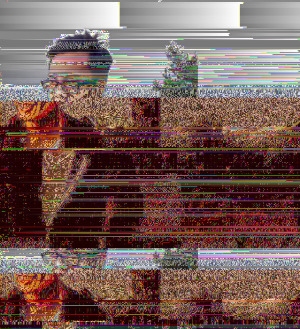
I've been having fun with the chaotic randomness of photo glitching, the way a child has fun with the spray paint tool in MS Paint. I know it's an old hat to a certain type of New Aesthetic graphic designer, and I know I'm not really doing anything interesting with it — but I've been randomly acquiring graphic design skills for nearly 10 years now, at some point I ought to learn how to create this type of warped, digital static and fragmentation. It's a tool to have.
I got curious about it because Warren Ellis was singing the praises of an iPhone app that took care of the nitty gritty photo glitching for you. Being an Android user, the app wasn't available to me, but I knew there were other ways around it. An app like decim8 is just a clean, accessible version of glitching the way Instagram is just a clean, accessible version of vintage photography. So with a quick Google, I found out glitching was really simple, done in under a minute, and weirdly fun.
Much like the faux-vintage cool of Instagram, photoglitching's appeal is in purposely fuxin' with something to create some illusion of artistry and authenticity. It's hipster chic that looks to the future instead of the past. The key here is that doing it yourself is more than just selecting a filter, it's about experimentation and the simple implications of little things.
All it is is taking a picture file in a certain format, opening it up in a text editor, deleting things, and seeing what happens. You use a barebones text editor like Notepad, Wordpad, or HTML editors like Notepad++. Better yet, use all three — that's the fun. Different file types do different things in different editors, even on different operating systems. Messing with a BMP scrambles the order & hue of the photo. A PNG creates harsh static, a TIFF warps like old VHS tapes. On Windows 7, Wordpad doesn't do much differently, but on older operating systems, even saving untouched data on Wordpad throws a huge wrench into how the file is read.
Then there's the question of what you're deleting and what it does. It's pure trial and error. You stare into the unintelligible glyphs, the matrix in every JPEG, and you pick spots at random to see your results. What happens if you delete a huge chunk? A single character? From the beginning of a file or the end?
I've found that most of the code at the top, especially in a PNG, is important to maintain the file's "stability." It is very easy to corrupt a picture so that it cannot be opened in Preview or Photoshop. I made a few dozen files last weekend, running them through different ringers — corrupt a BMP, save it as a PNG, make a copy, add minor glitches, add different glitches on the copy, resave them all — there are a million combinations. And it's easy. There's a stupid simplicity to the whole thing that turns out rewards that well outweigh the work you put in.

The last time I went to San Diego Comic Con, I made sure to get a sketch from one of my favorite illustrators, Francis Manapul. This was when his star was on the rise, but he had not yet revealed himself to be a company superstar. There wasn't a lot of traffic at his end of Artist's Alley, and he was a kind enough dude to do a quick, free sketch. With one hand holding up the pad, and the other holding up a brush, he whipped up a quick Superboy in a few strokes.
"I wouldn't even be able to hold up a pad with one hand, let alone draw on it."
"It's not really about control," he said. "It's more like managing the chaos."
He was just laying down thick lines and deciding what to do from there, letting the chaos of each stroke dictate how he would wrangle it in with the next one. And that's fun. The unpredictability of it makes it experimental and mysterious, though we have little chance of understanding it. It's art made from math, strictly adhering to algorithms, a painting completely free of the human mind.
